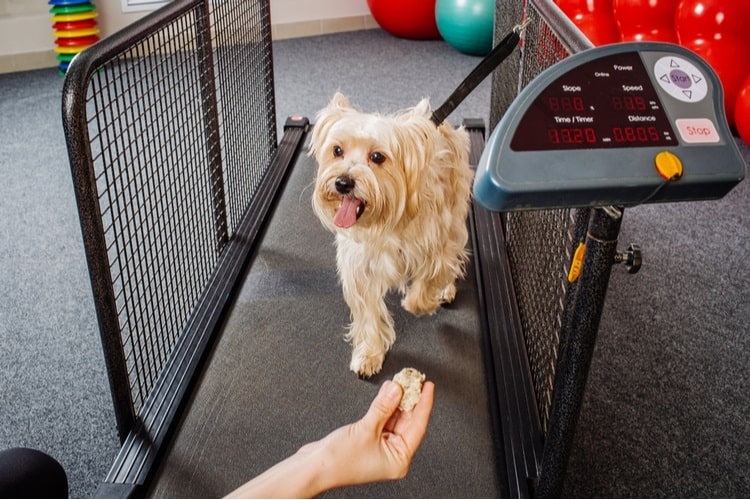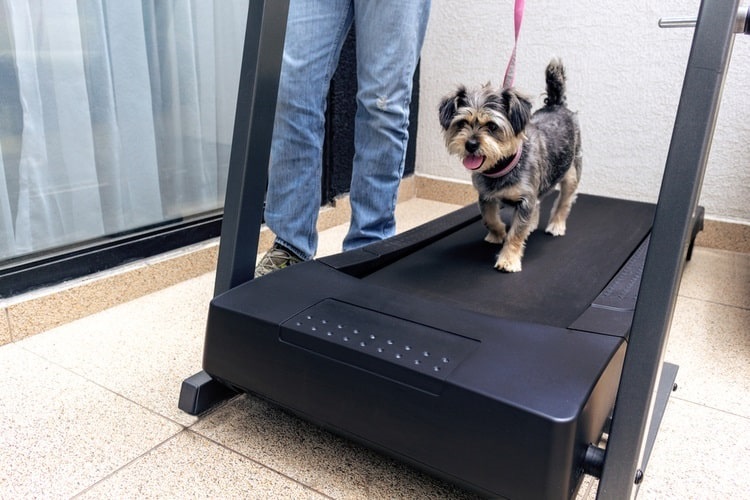Training your dog to use a treadmill is an excellent way to ensure daily exercise for your dog, even when your regular outdoor walks aren’t an option. This post will describe the six key steps to train your dog to use a treadmill.
There are many benefits of exercise for dogs. Adequate exercise is one of the main factors in determining the health and longevity of our canine companions (our guide can help you answer the question how much exercise does a dog need?). It’s also true that getting your pup their daily exercise isn’t always an easy task. Time constraints, weather, and inadequate space are all issues that we’re up against, so sometimes you need to get creative to ensure your dog is getting enough daily exercise. Enter the world of treadmills for dogs.
Benefits of Using a Treadmill for Your Dog
Treadmills offer many benefits when it comes to getting your pup the exercise that they need. First, you won’t have to monitor the weather. If the snow is over your pup’s head, the rain is coming down in sheets, or the pavement is paw-toasting hot, your dog won’t have to go outside in those conditions.
Another benefit is that you no longer need to go out after dark. Worried about safety issues surrounding early morning or late-night walks? Not with a doggie treadmill. Your pup can get their exercise from the comfort and safety of your own home.
Finally, your dog will get their exercise even if you can’t. Whether you’re in the middle of cooking dinner, your video conference is lasting longer than you’d like, or your knee is bothering you from last weekend’s hike, your pup can still stretch their legs. Some dogs may also be looking for a more intense workout than what we can provide for them. A treadmill is a great way to allow your dog to run or walk at a speed and incline that you might not be able to handle yourself.
General Guidelines for Training Your Dog to Use a Treadmill

Before we get into how to train your dog to use a treadmill, there are a few guidelines to go over.
- Never leave your dog unsupervised. Treadmills aren’t a babysitter. You need to be around to ensure that your pup isn’t getting overworked or to intervene if he gets a toenail stuck or falls off and gets hurt.
- Take it slow. Treadmills can be scary for dogs! Think about it. What dog would be okay with a noisy, moving floor right away? Make sure your pup is completely comfortable with the treadmill before you plan for daily workouts, and be sure to get them off of it promptly if they show any signs of apprehension or uneasiness.
- Wait until your puppy is done growing (there are plenty of other items that can help make use of that puppy energy on our new puppy shopping checklist in the meantime).1This will help ensure that they are coordinated enough to use a treadmill safely. For small breeds that means 10-12 months. Medium breeds continue to grow until 12-15 months, large breeds until around 18 months, and giant breeds up to two years old. Our puppy to dog growth calculator helps with predicting dog size.
- Make sure you have the proper treadmill. Be sure that you have an appropriately sized treadmill for your pup. It should go a speed that is suitable and safe. It should also not be so noisy that it scares the neighbor’s dog.
Six Steps to Train Your Dog to Use a Treadmill
Don’t expect your dog to jump on a treadmill and run with it straight out of the box. Rather, taking a step-by-step approach is the best way to train your dog to use a treadmill.
1. Let your pup get used to the treadmill.
Allow your dog to sniff the treadmill, get on it, and explore it without being expected to walk or run. Let them get completely comfortable with having it around and reward them with praise or treats when they get on it without apprehension.
If your pup simply isn’t interested in the treadmill, start by having them step onto it. Give them some basic commands like sit or stay and reward when they do it. This is all done with the power off.
2. Now, turn the power on.
Go through the previous step with the power on. Let your dog get used to the sound and watch the movement. Don’t ask your pup to get on a moving treadmill but just let them watch from the sidelines with encouragement. If your pup is at all uncomfortable with this step, repeat the first step until they’re ready to move on.
3. It’s time to get your dog moving.
With your pup standing on the treadmill, start it at its lowest speed. It’s best to have your pup on a leash for this step to prevent them from jumping off and hurting themselves. Keep it slow, keep the amount of time that they’re on it short, and give them pets and encouragement the entire time.
4. Gradually increase the speed.
Now that your dog has gained some confidence with the treadmill, it’s time to increase the speed. Do so in gradual intervals so that it’s not overtaxing or scary, and only for the length of time your dog is comfortable. Again, keep the length of time short until you know how much your dog can handle or wants to do, and remember to reward your pup.
5. Train for the dismount of the treadmill.
Don’t just let your dog jump off when they’re finished. Instead, make it a more controlled exit. Have them stand or sit, and then have them get off with a command. That way they’ll be less likely to jump off while the treadmill is moving and hurt themselves.
6. Keep it up!
If your dog doesn’t love it the first time, no big deal. Just keep trying over and over with lots of encouragement and patience. Go back to the previous step if your dog shows any apprehension with any of the training.
Even if your pup takes to the treadmill right away, it’s still important to increase speeds and time slowly so that they don’t overdo it.
Final Thoughts
A dog treadmill is a great way to get your dog the exercise that they need to stay happy and healthy. However, getting them to use a treadmill is going to take some time and patience that will be more than worth it in the end.
If the reason for a treadmill is that you’re particularly concerned about your dog’s weight, we have a series of resources on that topic as well that you might find helpful. Our puppy calculator can let you know how big your dog is likely to be, our list of foods dogs can and can not eat can help you figure out what’s safe to feed your dog, our dog size chart by weight can help you identify different inflection points in your dog’s growth, and our collection of breed-specific growth charts can help you get a better sense of the ideal weight for your full grown goldendoodle, full grown great dane, full grown golden retriever, full grown chihuahua, or full grown labrador.
Article Sources
Pet News Daily uses only high-quality sources, including peer-reviewed studies, to support the facts within our articles. Read our editorial process to learn more about how we fact-check and keep our content accurate, reliable, and trustworthy.
- Hawthorne AJ, Booles D, Nugent PA, Gettinby G, Wilkinson J. Body-weight changes during growth in puppies of different breeds. J Nutr. 2004;134(8 Suppl):2027S-2030S. doi:10.1093/jn/134.8.2027S

